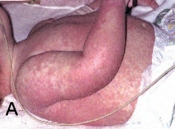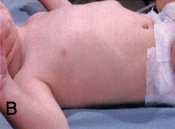Considerable evidence supports the use of behavioral approaches in the treatment of feeding disorders
Case Presentation
Diffuse DermatitisAn 18-month-old male was hospitalized for evaluation of a diffuse rash, failure to gain weight, diffuse edema, and irritability. Initially, developmental milestones were acquired at the expected time and in the expected

order, but had reached a plateau over the preceding several months. On physical examination, he was underweight and profoundly edematous. He had a diffuse dermatitis that spared only his face and genital area (Figure 1A). Laboratory studies were remarkable for irondeficiency anemia, hypoproteinemia, hyponatremia, mildly increased ALT, and deficiency of zinc and selenium.
The patient was evaluated by his pediatrician and secondary to presumed dietary intolerances, picky eating, and poor intake, he was started on rice milk at the age of 12 months. Over several months his intake of rice milk increased and eventually constituted 75 percent of his calories. Community therapy services were initiated including occupational therapy for sensory integration therapy and speech and language therapy for feeding problems and language disorder, but his condition continued to worsen and he was hospitalized.
Treatment Description
Nutritionally RehabilitatedA diagnosis of protein-energy malnutrition (PEM) was made and careful nutritional rehabilitation was started. PEM, also known as kwashiorkor, is rare in developed countries and occurs in the setting of food faddism or dietary misinformation (Katz, Mahlberg, Honig, & Yan, 2005; Williams, 1963). PEM is a systemic illness that affects most organ systems and explains our patient’s constellation of symptoms. The nutritional composition of rice milk makes it an inadequate primary source of nutrition for infants and young toddlers as it places these at risk for PEM and other nutritional deficiencies. This patient’s nutritional rehabilitation required careful monitoring and both parenteral and nasogastric feeding. Food allergy testing was negative. After 17 days, he was discharged to the outpatient setting nutritionally rehabilitated (Figure 1B).
of food faddism or dietary misinformation (Katz, Mahlberg, Honig, & Yan, 2005; Williams, 1963). PEM is a systemic illness that affects most organ systems and explains our patient’s constellation of symptoms. The nutritional composition of rice milk makes it an inadequate primary source of nutrition for infants and young toddlers as it places these at risk for PEM and other nutritional deficiencies. This patient’s nutritional rehabilitation required careful monitoring and both parenteral and nasogastric feeding. Food allergy testing was negative. After 17 days, he was discharged to the outpatient setting nutritionally rehabilitated (Figure 1B).
After an interdisciplinary team evaluation, behavior therapy with nutrition monitoring was initiated. The primary treatment goal was to improve the quality of oral nutrition by: 1) introducing new foods, 2) improving the pace of feeding, and 3) reducing the frequency and severity of feeding-related tantrums. Behavioral therapy consisted of: 1) the provision of written information including descriptions of intervention techniques to be used; 2) therapist modeling intervention techniques during simulated meals; 3) in vivo coaching to refine parenting skills; and 4) review of video-recorded feeding from the home environment.
The family returned for four alternate-week behavior therapy sessions. First session recommendations emphasized environmental controls, mealtime structure, and schedule. Specific recommendations included having all meals at the table in a distraction free environment, foods on the plate before calling the child to the table, creation of ridged mealtime characteristics, and meals and snacks two hours apart to promote hunger during meals. A schedule of three meals and three snacks was recommended. Meals were to be no more than 20 minutes in duration, and a wind-up timer was to be placed in front of the child. A booster seat with a secure strap was also recommended.
The second session emphasized contingency management training to develop reinforcement strategies used in the home environment. The family was taught to differentially reinforce bite acceptance, rapid swallowing, and appropriate behaviors at the table. Tangible reinforcers (stickers) were also given for reaching specified food/formula volume goals. The third session emphasized extinction strategies including timeout at the table and sustained presentation of new/non-preferred foods until a minimal exposure of five bites were accepted. The fourth session taught shaping procedures to gradually expand the diet, and emphasized parent training to help the family maintain treatment effects.
Nine months after hospitalization, nutrition remained stable off nasogastric supplementation, but feeding was not yet developmentally appropriate. He underwent tonsillectomy resulting in gains approximating skills similar to same age peers. Seventeen months after his hospitalization, he accepted most food offered to him and was discharged from outpatient management.
Commentary
Medical therapy seldom improves symptoms rooted in behavior and/ or skill problems. Considerable evidence supports the use of behavioral approaches in the treatment of feeding disorders (Kerwin, 1999; Sharp, Jaquess, Morton, & Herzinger). Approximately half to two-thirds of children with feeding disorders present with mixed etiologies (Rommel, De Meyer, Feenstra, & Veereman-Wauters, 2003). The heterogeneity of feeding problems necessitates that clinicians carefully consider a broad range of factors including the medical history, developmental history, family variables, and caregiver resources when designing an individualized treatment approach. Ongoing consultation with other specialists, especially a dietitian and speech pathologist, is frequently necessary to monitor the safety of the therapeutic plan that can result in transient weight loss, inadequate nutrient intake, or that may unmask oral motor or swallowing deficits as behavioral resistance to feeding begins to resolve. Ultimately management relies on coordinated supervision between medical, dietitian, speech and language, and behavioral personnel.
Authors
-
Alan H. Silverman, PhD, Medical College of Wisconsin, Section of Pediatric Gastroenterology, Hepatology, and Nutrition
-
Mary Beth Feuling, MS, RD, CNSD, Children’s Hospital of Wisconsin, Department of Clinical Nutrition
-
Richard J. Noel, MD, PhD, Medical College of Wisconsin, Section of Pediatric Gastroenterology, Hepatology, and Nutrition
References
Katz, K. A., Mahlberg, M. H., Honig, P. J., & Yan, A. C. (2005). Rice nightmare: Kwashiorkor in 2 Philadelphia-area infants fed Rice Dream beverage. J Am Acad Dermatol, 52(5 Suppl 1), S69-72.
Kerwin, M. E. (1999). Empirically supported treatments in pediatric psychology: severe feeding problems. J Pediatr Psychol, 24(3), 193-214; discussion 215- 196.
Rommel, N., De Meyer, A. M., Feenstra, L., & Veereman-Wauters, G. (2003). The complexity of feeding problems in 700 infants and young children presenting to a tertiary care institution. J Pediatr Gastroenterol Nutr, 37(1), 75-84.
Sharp, W. G., Jaquess, D. L., Morton, J. F., & Herzinger, C. V. Pediatric feeding disorders: a quantitative synthesis of treatment outcomes. Clin Child Fam Psychol Rev, 13(4), 348-365.
Williams, C. D. (1963). The story of Kwashiorkor. Courrier, 13, 361-367.
 order, but had reached a plateau over the preceding several months. On physical examination, he was underweight and profoundly edematous. He had a diffuse dermatitis that spared only his face and genital area (Figure 1A). Laboratory studies were remarkable for irondeficiency anemia, hypoproteinemia, hyponatremia, mildly increased ALT, and deficiency of zinc and selenium.
order, but had reached a plateau over the preceding several months. On physical examination, he was underweight and profoundly edematous. He had a diffuse dermatitis that spared only his face and genital area (Figure 1A). Laboratory studies were remarkable for irondeficiency anemia, hypoproteinemia, hyponatremia, mildly increased ALT, and deficiency of zinc and selenium. of food faddism or dietary misinformation (Katz, Mahlberg, Honig, & Yan, 2005; Williams, 1963). PEM is a systemic illness that affects most organ systems and explains our patient’s constellation of symptoms. The nutritional composition of rice milk makes it an inadequate primary source of nutrition for infants and young toddlers as it places these at risk for PEM and other nutritional deficiencies. This patient’s nutritional rehabilitation required careful monitoring and both parenteral and nasogastric feeding. Food allergy testing was negative. After 17 days, he was discharged to the outpatient setting nutritionally rehabilitated (Figure 1B).
of food faddism or dietary misinformation (Katz, Mahlberg, Honig, & Yan, 2005; Williams, 1963). PEM is a systemic illness that affects most organ systems and explains our patient’s constellation of symptoms. The nutritional composition of rice milk makes it an inadequate primary source of nutrition for infants and young toddlers as it places these at risk for PEM and other nutritional deficiencies. This patient’s nutritional rehabilitation required careful monitoring and both parenteral and nasogastric feeding. Food allergy testing was negative. After 17 days, he was discharged to the outpatient setting nutritionally rehabilitated (Figure 1B).